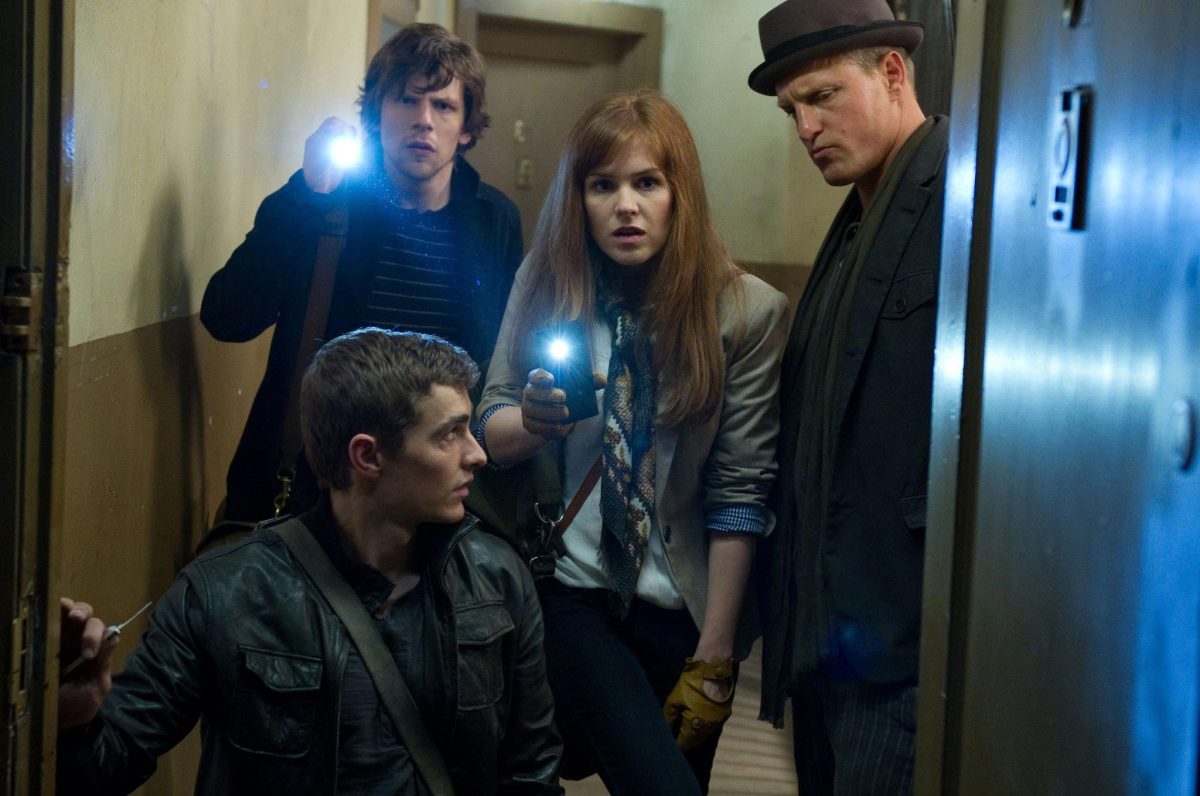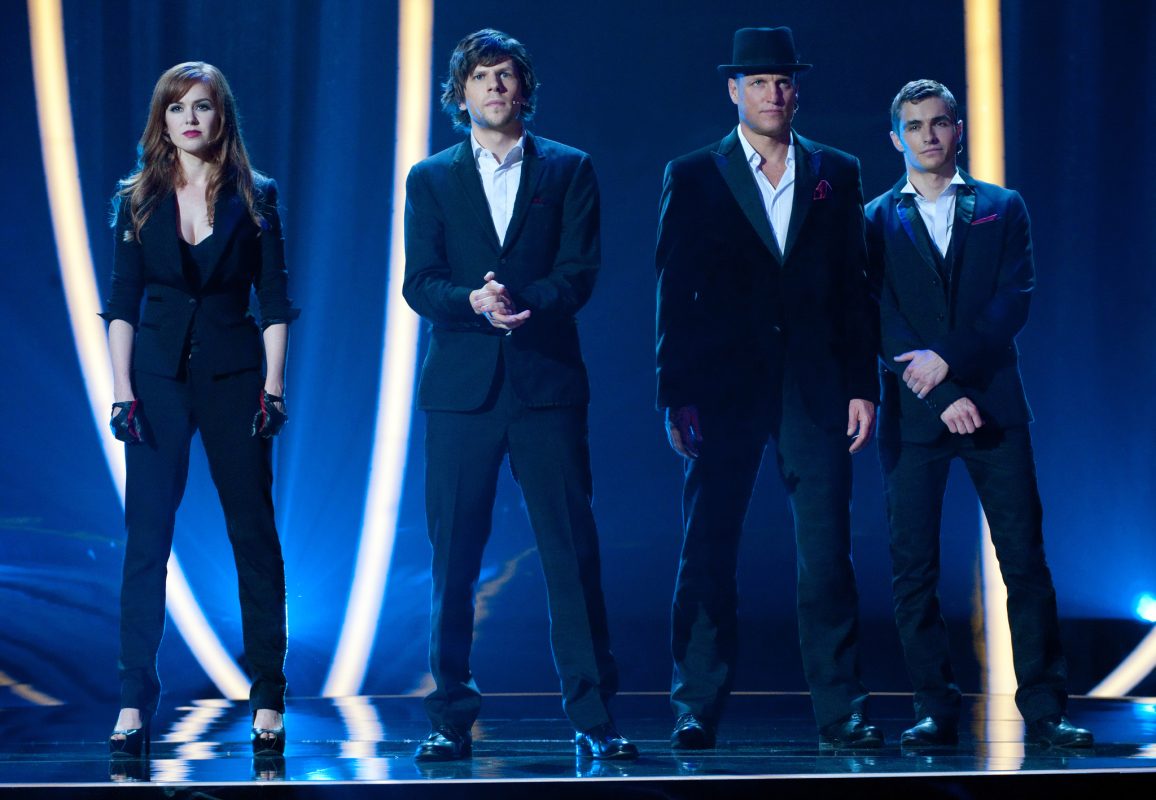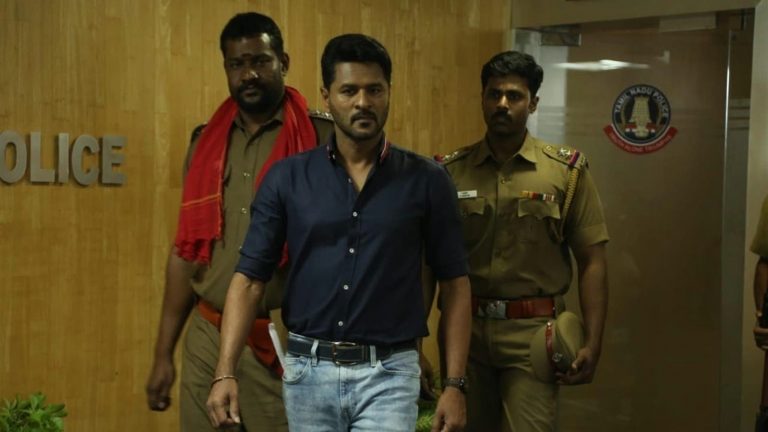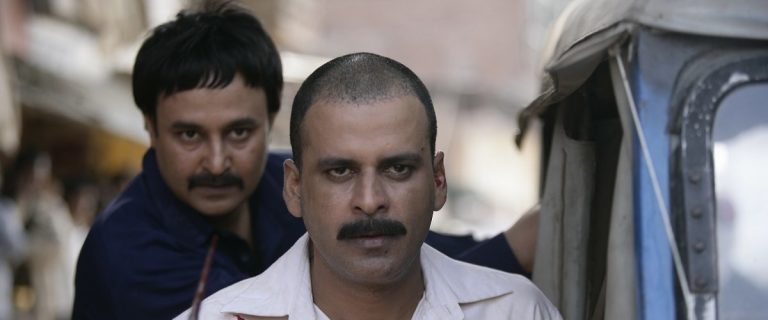Louis Leterrier’s Now You See Me (2013) presents itself as a sleek heist thriller about four charismatic magicians staging impossible robberies. Yet beneath the bravado, card tricks, and playful misdirection lies a story about legacy, vengeance, and the most extravagant manipulation of perception—where truth itself becomes the ultimate magic trick. Everyone believes they’re holding the winning deck, right up until the final reveal shows that the real magician has been standing before them all along.
Spoilers Ahead
Now You See Me (2013) Plot Summary & Movie Synopsis
The four prodigious illusionists – sleight-of-hand virtuoso J. Daniel Atlas, escape artist Henley Reeves, mentalist Merritt McKinney, and street magician Jack Wilder–have received strange tarot cards beckoning them to a secret apartment in New York City. There, they are introduced to a holographic blueprint for a series of illusions that none of them could perform alone. Someone is fabricating them, modifying them, gathering them together into something much larger.
One year later, they have emerged as The Four Horsemen, financed by billionaire Arthur Tressler. Their act in Las Vegas culminates with an astonishing trick by teleporting a member of the audience into a bank vault in Paris, all the while showering the crowd in Nevada with stolen euros. It’s shocking, exhilarating, and not to mention, real. FBI agent Dylan Rhodes and Interpol Detective Alma Dray try to expose them, but every time the law gets close, the Horsemen are already a step ahead.
Who are the Four Horsemen and Why Do They Follow a Leader They’ve Never Met?
Each Horseman is driven by a different wound.
- Daniel Atlas is a perfectionist obsessed with controlling every variable. To Atlas, magic is precision. He believes he’s the natural leader. And that belief is exactly why he’s easy to manipulate. He never questions why he’s being chosen; being the best is his identity.
- Henley Reeves is a daredevil illusionist always trying to break free from both physical traps and her past with Atlas. Her leap into the Horsemen is an opportunity to be part of something monumental, something that recognizes her talent beyond being Atlas’s former assistant.
- Merritt McKinney is a once-famous mentalist now struggling with debt and faded relevance. He joins because it gives him purpose again, and because the mysterious benefactor seems to know exactly how to pull his strings.
- Jack Wilder is the youngest and hungriest, eager to prove he belongs. Jack is the perfect disciple: reckless, loyal, and willing to sacrifice everything for the greater illusion.
None of them knows who is guiding them. Yet they trust the blueprint because it demands everything they crave: attention, redemption, legacy, and power. They follow the instructions because someone understands what they want better than they do.
How Do the Horsemen Pull Off the First Heist?
When they ‘rob’ the Paris bank, the Horsemen stage not just a trick, but a narrative. The audience thinks a random volunteer is selected. Thaddeus Bradley, a magician-turned-debunker, later reveals the truth. The man was preselected and hypnotized. A replica vault was built beneath the stage. The real cash was stolen days earlier. The euros tossed on the audience were flash paper programmed to disintegrate.
The opening heist establishes their methodology – control the participant, control the set, control the timing, and control the perception of the audience. Every trick is a heist. Every heist is a performance, and performance hides an agenda none of the Horsemen themselves fully understand.
Why is Dylan Rhodes Obsessed with Catching Them?
Dylan seems like the classic ‘angry federal agent’: impatient, clumsy, constantly chasing shadows. But that’s the illusion. His actions appear erratic. He always arrives one step late. The Horsemen always escape. His phone is somehow always compromised. He loses Jack in a car chase. And he seems too emotional to think straight. This is deliberate. Dylan’s incompetence is the trick. To the FBI, he’s a frustrated agent, and to the Horsemen, he’s a foe who keeps falling behind, and to Thaddeus Bradley, he’s a cop in over his head. But in truth, Dylan is choreographing a dance where everyone believes the wrong thing. He controls the investigation by losing control.
Who is Alma Dray?
Alma is the only investigator who doesn’t get blinded by ego. While Dylan wants to ‘catch the bad guys,’ Alma asks: Why are they doing this? Who benefits? What pattern are we missing? She studies the symbolism, the tarot cards, and the history of secret magician societies. She alone suspects the existence of the Eye, an ancient order dedicated to using magic to redistribute power from the corrupt to the oppressed. While Dylan dismisses her theories, she keeps searching for meaning. And ironically, she gets closer to the truth than anyone, because she’s the only one not trapped inside Dylan’s illusion.
Why Does Tressler Turn Against the Horsemen?

When the Horsemen empty Arthur Tressler’s bank accounts during their New Orleans show, they turn a wealthy insurance mogul into a symbol of corporate greed. Tressler becomes driven by humiliation, not justice. He hires Thaddeus Bradley, someone who profits by exposing illusions, to expose the Horsemen. But both men are pawns in a larger revenge story they don’t even know they’re part of.
What Really Happened to Jack Wilder?
Why does a magician fake his death? When Jack crashes his car, dies in a fiery explosion, and leaves behind evidence, every character reacts emotionally. Dylan is devastated as his suspect is dead. Alma is suspicious.
The Horsemen mourn a teammate, and Thaddeus thinks he’s won. But Jack’s entire death is a stage trick. He crashes a decoy car, plants a cadaver, and escapes underwater. His ‘death’ is the turning point where the Horsemen fully commit to their unseen leader. Jack dies so he can perform the most important trick of the entire operation, breaking into Elkhorn’s real safe while the FBI is rushing toward a fake one. The illusion isn’t just about misdirection. It’s about sacrifice for a greater design.
Why is Thaddeus Bradley Framed?
Thaddeus believes he’s the smartest man in the room. He prides himself on seeing through illusions. But his flaw is arrogance. He assumes the Horsemen target him because he exposed magicians years ago. He thinks they’re simply showboaters seeking revenge. Dylan counts on that arrogance. So the Horsemen frame Thaddeus by planting the stolen Elkhorn money in his car. The man who claims to debunk illusions becomes the fall guy for the greatest illusion of all. He doesn’t realize he was inside the trick from the beginning.
Now You See Me (2013) Movie Ending Explained:
Who is the Real Mastermind Behind the Four Horsemen?
Inside the prison cell, Thaddeus finally notices what the audience missed. Dylan Rhodes has been orchestrating everything. He manipulated the FBI investigation and guided the Horsemen without revealing his identity. He fed Thaddeus clues to keep him busy. Moreover, he staged Jack’s death and engineered every heist. Dylan reveals why. His father was Lionel Shrike. A magician publicly humiliated by Thaddeus three decades earlier. After Bradley exposed Shrike’s tricks, Lionel attempted an escape stunt using an Elkhorn safe, the same brand the Horsemen later rob.
Also Read: Is There a ‘Now You See Me 3’ (2025) End-Credits Scene? Should You Stay After the Movie?
The safe malfunctioned. Shrike drowned inside. The bank refused the insurance claim. The institution that sold the safe profited. And Tressler’s company denied Shrike’s payout. Dylan was a boy watching his father die. His entire life has been building toward this – Elkhorn Safe getting punished for causing his father’s death. Crédit Républicain and Tressler were punished for denying insurance. Thaddeus Bradley was punished for ending Shrike’s career. Every heist is an act of vengeance disguised as showmanship. Every illusion is a monument to a father’s memory.
When Alma meets Dylan in Paris and pieces together the truth, she faces a moral crossroads. She knows Dylan manipulated global law enforcement and framed a man. But she also recognizes that Dylan’s pain is real. His cause comes from trauma, not greed. The Horsemen’s actions helped people left behind by corrupt systems, and she has grown to care for him. Alma chooses compassion over protocol, mirroring Dylan’s father, a man who believed that magic was meant to inspire hope, not cynicism. She lets the illusion stand.
What Does the Final Carousel Scene Reveal About ‘The Eye’?
In Central Park, the carousel lights whirl like the inner gears of a grand illusion. Dylan meets the Horsemen and welcomes them into the Eye, confirming the society is real. The Eye values precision, justice, balance, and belief. The Horsemen enter not as thieves but as disciples of a philosophy older than any of them. Use misdirection to reveal the truth, then use illusion to expose corruption, and finally use spectacle to challenge power. Every character in the film is watching a different version of the same trick.
The Horsemen think they’re following a mysterious order, Thaddeus thinks he’s exposing fraud, and Tressler believes anarchists are robbing him. The FBI thinks it’s dealing with criminals, while the audience thinks it’s seeing impossible magic. But Dylan Rhodes is the only one who understands the real illusion.

The film’s final message becomes clear: look closely, because the closer you think you are, the less you’ll actually see. It’s not just a line. It’s the philosophy behind the entire story. Dylan doesn’t win because he outsmarts everyone. He wins because he understands a truth his father believed in: Magic isn’t about tricking people, it’s about showing them what they refuse to see. The revenge, the heists, the spectacle – those are just smoke and mirrors. The real illusion is perception. And Dylan mastered it long before the Four Horsemen ever took the stage.
Theme of Now You See Me (2013) Movie Themes Analysed:
Illusion as Justice, and Justice as Illusion
At first glance, “Now You See Me” is a flashy spectacle filled with card tricks, heists, and sleek misdirection. But beneath its showman’s flair lies a story about who controls the narrative—and how easily that control can be taken away. The film’s central theme revolves around the power of illusion, not just as a magician’s tool, but as a weapon for redistributing power, correcting injustice, and reshaping perception. The entire story rests on one fundamental idea that the truth doesn’t matter as much as what people can be convinced to see. This theme manifests through the characters, their motivations, and the hidden structure of the plot.
Illusion as a Tool to Expose Corruption
Throughout the film, the Horsemen target institutions built on exploitation. A bank that denies insurance payouts, an insurance mogul profiting off disaster victims, and a company selling unsafe safes that led to Lionel Shrike’s death. Each target is powerful, wealthy, and protected by legal loopholes. Traditional justice can’t touch them. So the Horsemen use illusion to create a new kind of justice, one that bypasses the courts and delivers consequences publicly, theatrically, and symbolically. Their tricks are not random acts of rebellion. They are moral recalibrations wrapped in spectacle.
Misdirection as the Language of Power
The film suggests that the world already runs on illusions, just not the fun kind. Corporations hide behind complicated contracts. Insurance companies rewrite fine print. Media personalities (like Thaddeus Bradley) shape narratives for profit. Law enforcement pretends to control chaos but often chases shadows. In this world, the Horsemen don’t disrupt the system; they reveal it. Every heist mirrors a real-world tactic used by the powerful: distraction, manipulation, psychological control, and misinformation. The only difference? The Horsemen use these tactics to help the powerless instead of exploiting them.
Revenge as a Performance
At its core, “Now You See Me” is also about a son’s grief. Dylan Rhodes transforms his trauma into a multilayered illusion that doubles as both justice and revenge. His father’s death represents: the failure of institutions, the failure of safety standards, the failure of compassion, and accountability. Dylan’s entire plan is a performance staged to correct all of those failures at once. By turning revenge into a grand illusion, Dylan reframes vengeance as justice, though the morality of that choice remains intentionally ambiguous.
The Eye and the Search for Meaning
The secret society, ‘the Eye,’ represents the oldest theme in magic: the tension between illusion and revelation. Alma Dray becomes the audience surrogate in this search for meaning. She wants to believe magic can have purpose, not just deception. Her arc reflects a symbolic idea: People crave something true in a world full of illusions. And paradoxically, the “truth” she finds is that the illusion itself is part of a larger moral order.
What the Film Ultimately Says
If the film were to express its thesis in one message, it would be this: Perception is the real currency of power. Those who control what others see control the world. Every plot thread reinforces this: the Horsemen use illusion to expose injustice. Dylan uses illusion to rewrite his father’s legacy. Thaddeus uses illusion to build a career, destroying illusions. Institutions use illusion to hide their failures. The film doesn’t claim illusion is good or bad. It claims illusion is inevitable. The question is: who gets to wield it and for what purpose?





![What Still Remains Review [2018]: A Question That is Successfully Asked](https://79468c92.delivery.rocketcdn.me/wp-content/uploads/2018/08/Select5-768x512.jpg)
